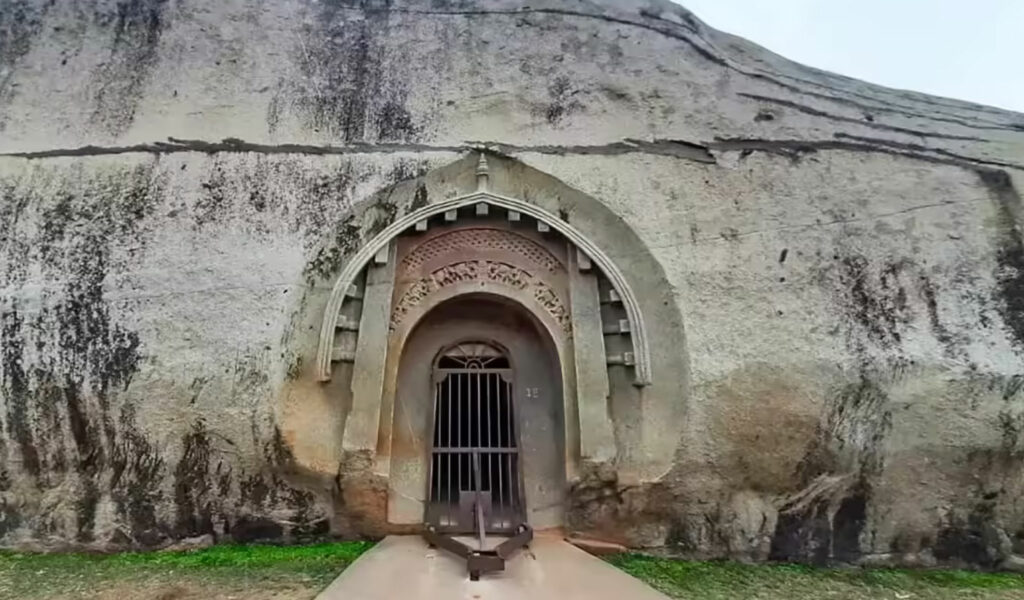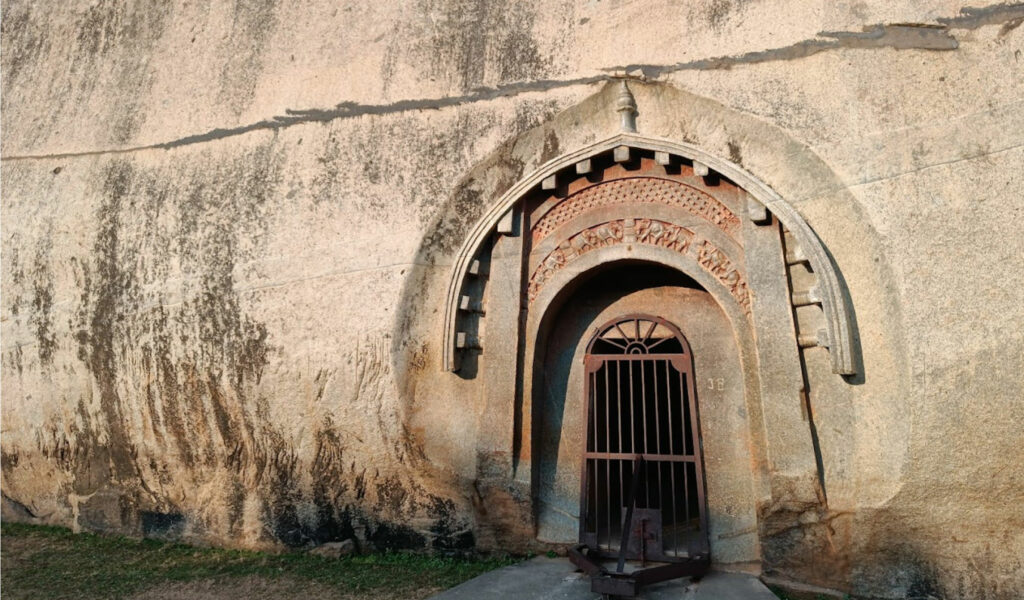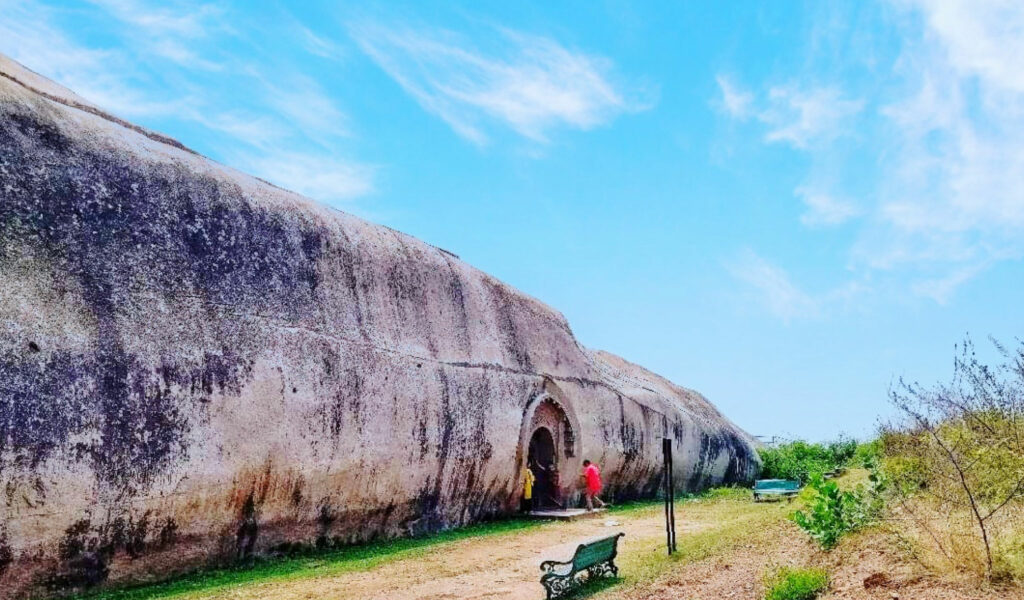Barabar Caves, located in the Jehanabad district of Bihar, India, are among the oldest surviving rock-cut caves in the country. Dating back to the Mauryan period (3rd century BCE), these caves offer a fascinating glimpse into India’s ancient history, architecture, and spiritual heritage.
Historical Significance of Barabar Caves

The Barabar Caves are a priceless treasure of India’s ancient heritage, holding immense historical and archaeological significance. Dating back to the 3rd century BCE, these caves are widely considered the earliest surviving examples of rock-cut architecture in India, making them a cornerstone in the evolution of Indian cave architecture.
These caves were primarily associated with the Ajivikas, an ascetic religious sect that flourished during the Mauryan Empire. The Ajivikas practiced strict asceticism and believed in the doctrine of fate (Niyati), which held that all events were preordained. The serene and isolated location of the Barabar Hills made the caves ideal for their meditation and spiritual practices.
Emperor Ashoka (273–232 BCE), renowned for his patronage of Buddhism, also supported other religious sects. He dedicated some of the Barabar Caves to the Ajivikas, which is evident from inscriptions found inside the caves. These inscriptions not only reflect his religious tolerance but also provide valuable historical records of the era.
Later, Dasaratha Maurya, Ashoka’s grandson, continued the tradition of patronage by dedicating additional caves to the Ajivikas. This demonstrates the continuity of Mauryan support for ascetic communities even after Ashoka’s reign.
One of the most striking aspects of the Barabar Caves is that they predate the celebrated Buddhist cave complexes of Ajanta and Ellora by several centuries. This early example of rock-cut engineering laid the foundation for the architectural and artistic innovations that would later flourish in India’s cave temples and monasteries.
In essence, the Barabar Caves are not just architectural marvels—they are living chronicles of Mauryan history, reflecting religious diversity, royal patronage, and the origins of Indian rock-cut architecture.
Architectural Features of Barabar Caves

The Barabar Caves are celebrated as masterpieces of early Indian rock-cut architecture, showcasing the engineering genius of the Mauryan period. Despite being over 2,200 years old, their design and craftsmanship continue to astonish historians, archaeologists, and travelers alike.
1. Rock-Cut Precision and Engineering
The caves were entirely carved out of hard granite, a feat that required exceptional skill and tools for the time. Unlike later cave complexes that often feature multiple chambers, the Barabar Caves are simple, monolithic chambers, yet they demonstrate extraordinary precision. The smoothness of the cuts and the geometrical accuracy suggest that Mauryan craftsmen were highly advanced in stone-cutting techniques.
2. Polished Interiors (Mauryan Polish)
One of the most iconic features of the Barabar Caves is the mirror-like polish on the interior walls, commonly referred to as the Mauryan polish.
- The granite walls are so smooth and reflective that they create a shiny, almost metallic appearance.
- Even after more than two millennia, this fine polish remains intact, highlighting the durability and sophistication of Mauryan craftsmanship.
3. Acoustic and Echo Effects
The caves are also famous for their unique acoustics.
- Sounds produced inside the chambers echo distinctly, creating a resonant effect that would have enhanced chanting, prayers, or meditation practices of the Ajivikas.
- This natural echo phenomenon is believed to have been an intentional feature of the design, connecting architecture with spiritual experience.
4. Simple Yet Symbolic Layout
Most Barabar Caves consist of:
- A rectangular entrance hall (mandapa)
- A circular or semi-circular inner chamber (garbhagriha-like space)
This two-part layout may have been designed to:
- Provide a transition from the outside world to the meditative inner chamber.
- Enhance the acoustic effects and create a sense of spiritual isolation.
5. Distinctive Cave Examples
- Lomas Rishi Cave: Famous for its arched facade resembling wooden architecture, with a chaitya arch designthat inspired later Buddhist cave temples.
- Sudama Cave: Dedicated to the Ajivikas by Ashoka in 261 BCE, featuring a semi-circular chamber with excellent acoustics.
- Karan Chaupar Cave: A simpler cave with Mauryan inscriptions, showcasing the functional aspect of early rock-cut design.
Architectural Legacy
The Barabar Caves represent the genesis of India’s cave architecture tradition.
- Their polished interiors, precise geometry, and spiritual design served as inspiration for later cave complexes, including Ajanta, Ellora, and Udayagiri-Khandagiri.
- They also reflect the early fusion of architecture and spirituality, where the physical structure enhanced the meditative experience
Spiritual and Cultural Importance of Barabar Caves

The Barabar Caves are not just archaeological marvels—they are also profoundly spiritual spaces that reflect the diverse religious traditions of ancient India. Their location, design, and inscriptions reveal how these caves served as centers of meditation and ascetic life for multiple religious sects, shaping the cultural history of Bihar and the Mauryan Empire.
1. Early Use by the Ajivikas
- The Ajivikas, an ascetic sect contemporary to Buddhists and Jains, were the first occupants of the Barabar Caves.
- They believed in Niyati (Fate), a doctrine emphasizing that all events are predestined and beyond human control.
- The serene and isolated Barabar Hills provided the perfect retreat for their meditation and spiritual practices.
- Inscriptions inside the caves by Emperor Ashoka confirm that these caves were dedicated to Ajivika monks in the 3rd century BCE.
2. Royal Patronage and Religious Tolerance
The Mauryan dynasty, particularly Ashoka and Dasaratha Maurya, played a key role in promoting spiritual activities at the Barabar Caves.
- Ashoka, though a follower of Buddhism, supported multiple ascetic traditions, reflecting his policy of religious tolerance.
- His inscriptions highlight the coexistence of different spiritual paths under the Mauryan Empire.
- Dasaratha Maurya continued this legacy, dedicating additional caves to the Ajivikas, ensuring the continuity of spiritual practices in the region.
3. Later Influence on Buddhist and Jain Traditions
- While the caves were initially built for Ajivika ascetics, their peaceful and remote environment later attracted Buddhist and Jain monks.
- The echoing chambers would have amplified chants and prayers, creating an immersive spiritual experience.
- The Lomas Rishi cave facade, resembling a chaitya arch, inspired the design of later Buddhist cave templessuch as Ajanta and Karla.
4. Cultural Legacy
- Today, the Barabar Caves symbolize India’s rich spiritual diversity and architectural innovation.
- They are a living testimony to the fusion of religion, architecture, and royal patronage in the Mauryan era.
- For pilgrims, historians, and travelers, the caves represent a timeless link to India’s ascetic traditions and ancient cultural values.
Traveler Tips for Visiting Barabar Caves
1. Best Time to Visit
The ideal time to visit Barabar Caves is from October to March, when the weather in Bihar is cool and comfortable. During this period, the temperature ranges from 15°C to 25°C, making it perfect for sightseeing and photography. Summer months can be extremely hot, while the monsoon season (July to September) can make the rocky paths slippery and challenging to navigate.
2. How to Reach
The nearest city is Gaya, located about 25 kilometers from the Barabar Caves, which serves as a convenient base for travelers.
- By Air: Gaya International Airport is the closest airport, with regular flights from major Indian cities.
- By Train: Gaya Junction is a major railway hub well-connected to Patna, Varanasi, and Kolkata.
- By Road: You can hire a taxi or take local transport from Gaya or Jehanabad to reach the caves. The scenic drive through the countryside adds to the experience.
3. Footwear & Clothing
Wear comfortable, sturdy shoes as the terrain around the caves is rocky and uneven, requiring some walking and light climbing. If visiting in summer, light cotton clothing, hats, and sunglasses are recommended to cope with the heat. In winter, a light jacket is sufficient for early mornings or evenings.
4. Carry Essentials
The Barabar Caves are located in a remote area with limited tourist facilities. It is advisable to carry water bottles, light snacks, and basic first aid. Mobile network coverage is available but can be weak in some spots, so download any navigation maps beforehand.
5. Photography
Barabar Caves are a photographer’s delight, offering a blend of ancient rock-cut architecture and natural landscapes. The best time for photography is early morning or late afternoon, when soft sunlight enhances the texture of the granite walls and the surrounding hills. Tripods are not mandatory but can help in low-light cave photography.
6. Safety Note
While the caves are safe to explore, exercise caution during the monsoon season, as wet granite surfaces become slippery. Avoid venturing too close to steep edges, and always follow designated paths to ensure safety.
7. Combine with Nearby Attractions
Enhance your Barabar Caves trip by exploring nearby heritage and spiritual sites. A visit to Bodh Gaya, a UNESCO World Heritage site and the place where Lord Buddha attained enlightenment, is highly recommended. Dungeshwari Hills (Mahakala Caves), where Buddha meditated before enlightenment, and the city of Gaya with its Vishnupad Temple can be part of a day-long or weekend itinerary.
Conclusion
The Barabar Caves stand as a timeless monument to India’s ancient heritage, offering a perfect blend of history, spirituality, and architectural brilliance. These caves, with their mirror-polished granite interiors, Mauryan-era inscriptions, and echoing chambers, are not just remnants of the past but living testaments to the skill, devotion, and vision of early Indian craftsmen and rulers. Walking through these caves allows travelers to step back over 2,200 years, experiencing the serenity that once inspired Ajivika ascetics, Buddhist monks, and later pilgrims.
For history enthusiasts, architecture admirers, and cultural explorers, the Barabar Caves offer an experience that is as educational as it is awe-inspiring. Their peaceful surroundings, coupled with their profound spiritual legacy, make them an ideal destination for anyone seeking to explore India’s lesser-known heritage sites. If you are planning a historical or cultural trip to Bihar, the Barabar Caves should be at the top of your itinerary, promising a journey through time that you will never forget.

